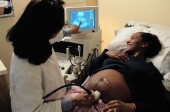
MONDAY, Aug. 30 (HealthDay News) — The rate of cesarean delivery in the United States continues to rise and steps are needed to reverse the trend, a new study finds.
From 1996 to 2007 the rate of cesarean delivery climbed by more than 50 percent, and “one in three first-time mothers are now being delivered by cesarean delivery,” lead researcher Dr. Jun Zhang, of the Eunice Kennedy Shriver National Institute of Child Health and Human Development, said during a press conference Monday.
In addition, more women than ever before are having repeat C-section deliveries and the rate of medically induced deliveries is high.
“We found that 44 percent of women who attempt vaginal delivery have their labor induced,” said Zhang, who is a senior investigator in the institute’s Division of Epidemiology, Statistics and Prevention Research. “In this [induced] group the C-section rate is twice as high as women who have spontaneous labor.”
He also noted that many cesarean deliveries were done at an early stage of labor, before the women even had a chance to spontaneously deliver.
The report is published in the Aug. 30 issue of the American Journal of Obstetrics and Gynecology.
Like any surgery, C-section comes with risks, explained Dr. Salih Yasin, an associate professor of obstetrics and gynecology at the University of Miami Miller School of Medicine.
“First, cesarean section is not just having a baby; it is having a baby through major surgery. So there is a chance of bleeding, infections and longer healing and recovery,” said Yasin, who was not involved in the new study. There are also the long-term effects of repeated cesareans on the uterus. “You end up having many more cases of cesarean-related hysterectomies and transfusion and maternal death,” he said.
While these consequences make up only a small percent of cases, “we are noticing an almost 10-times increase of those significant complications,” Yasin said. “We need to make sure we are doing this surgery to the right patient for the reason — the right timing for the long-term health of the patient,” he added.
In the new study, researchers working with the Consortium on Safe Labor collected data on cesarean delivery throughout the United States using data from almost 229,000 electronic medical records from 19 hospitals.
They found that 30.5 percent of all deliveries were done by cesarean section in 2007, including 31.2 percent of women having their first child.
Among women who underwent C-section due to an abnormal or difficult childbirth or labor (dystocia), half of the deliveries were done before the cervix had opened less than 6 centimeters — early in the labor process, Zhang said.
Among women who had a cesarean delivery before going into labor, about 31 percent had a uterine scar from an earlier pregnancy. A uterine scar can be caused by many conditions that damage the uterus. In some cases, scar tissue can prevent the uterus from fully dilating, thus resulting in a C-section.
However, almost 29 percent of women with a uterine scar did manage to have a normal vaginal delivery, the researchers noted. And in these cases, vaginal delivery was successful in about 6 out of 10 cases.
There are many reasons that could help explain why the number of cesarean deliveries is rising, the researchers said. These include women delaying childbirth until they are approaching middle-age, increasing obesity rates among pregnant women and the increase in multiple births due to the use of fertility treatments.
Also, when a woman has already had one C-section, doctors are likely to deliver her other children the same way. That’s a practice obstetrical experts have been trying to curb, however. In July, the American College of Obstetricians and Gynecologists issued new guidelines stressing that many women who’ve had a C-section may be candidates for vaginal birth in future pregnancies.
Litigation concerns on the part of doctors may be driving the trend towards C-sections, as well. Many obstetricians fear being sued should something go wrong in a vaginal delivery, the researchers noted.
“To make a significant impact on the high cesarean delivery rate in the United States, the focus should be preventing unnecessary primary cesarean deliveries from several aspects,” the researchers wrote.
First, there needs to be fewer induced deliveries, and performing a C-section in cases of problem birth should not be done before the start of labor — especially in women having their first child, the researchers said.
Vaginal delivery after an earlier cesarean should be encouraged, if possible, and there needs to be an accepted standard among physicians that indicates when a cesarean is needed, they added.
“Finally, increasing access to, and patient education on, trial of labor in women with a previous uterine scar and improving the [delivery] success rate are urgently needed,” the researchers said.
Zhang noted that one limitation of the study is that the sample the researchers used is not necessarily representative of the United States as a whole, since much of the data came from teaching hospitals, which tend to see more complicated pregnancies than community hospitals.
For his part, Yasin said he wasn’t surprised by the findings.
“That’s the way things are,” he said. “We are inducing labor more than we should. We are not being patient with or giving adequate time for women who are in labor. We are intervening before giving the patient every chance possible.”
More information
For more information on pregnancy, visit the U.S. National Institutes of Health.

